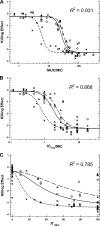Pharmacokinetic/pharmacodynamic investigation of colistin against Pseudomonas aeruginosa using an in vitro model
- PMID: 20585118
- PMCID: PMC2934992
- DOI: 10.1128/AAC.00903-09
Pharmacokinetic/pharmacodynamic investigation of colistin against Pseudomonas aeruginosa using an in vitro model
Abstract
Colistin plays a key role in treatment of serious infections by Pseudomonas aeruginosa. The aims of this study were to (i) identify the pharmacokinetic/pharmacodynamic (PK/PD) index (i.e., the area under the unbound concentration-time curve to MIC ratio [fAUC/MIC], the unbound maximal concentration to MIC ratio [fC(max)/MIC], or the cumulative percentage of a 24-h period that unbound concentrations exceed the MIC [fT(>MIC)]) that best predicts colistin efficacy and (ii) determine the values for the predictive PK/PD index required to achieve various magnitudes of killing effect. Studies were conducted in a one-compartment in vitro PK/PD model for 24 h using P. aeruginosa ATCC 27853, PAO1, and the multidrug-resistant mucoid clinical isolate 19056 muc. Six intermittent dosing intervals, with a range of fC(max) colistin concentrations, and two continuous infusion regimens were examined. PK/PD indices varied from 0.06 to 18 for targeted fC(max)/MIC, 0.36 to 312 for fAUC/MIC, and 0 to 100% for fT(>MIC). A Hill-type model was fit to killing effect data, which were expressed as the log(10) ratio of the area under the CFU/ml curve for treated regimens versus control. With fC(max) values equal to or above the MIC, rapid killing was observed following the first dose; substantial regrowth occurred by 24 h with most regimens. The overall killing effect was best correlated with fAUC/MIC (R(2) = 0.931) compared to fC(max)/MIC (R(2) = 0.868) and fT(>MIC) (R(2) = 0.785). The magnitudes of fAUC/MIC required for 1- and 2-log(10) reductions in the area under the CFU/ml curve relative to growth control were 22.6 and 30.4, 27.1 and 35.7, and 5.04 and 6.81 for ATCC 27853, PAO1, and 19056 muc, respectively. The PK/PD targets identified will assist in designing optimal dosing strategies for colistin.
Figures


Similar articles
-
Elucidation of the pharmacokinetic/pharmacodynamic determinant of colistin activity against Pseudomonas aeruginosa in murine thigh and lung infection models.Antimicrob Agents Chemother. 2010 Mar;54(3):1117-24. doi: 10.1128/AAC.01114-09. Epub 2009 Dec 22. Antimicrob Agents Chemother. 2010. PMID: 20028824 Free PMC article.
-
Pharmacokinetics/Pharmacodynamics of Pulmonary Delivery of Colistin against Pseudomonas aeruginosa in a Mouse Lung Infection Model.Antimicrob Agents Chemother. 2017 Feb 23;61(3):e02025-16. doi: 10.1128/AAC.02025-16. Print 2017 Mar. Antimicrob Agents Chemother. 2017. PMID: 28031207 Free PMC article.
-
fAUC/MIC is the most predictive pharmacokinetic/pharmacodynamic index of colistin against Acinetobacter baumannii in murine thigh and lung infection models.J Antimicrob Chemother. 2010 Sep;65(9):1984-90. doi: 10.1093/jac/dkq226. Epub 2010 Jun 23. J Antimicrob Chemother. 2010. PMID: 20573659 Free PMC article.
-
In vitro Pharmacodynamics and PK/PD in Animals.Adv Exp Med Biol. 2019;1145:105-116. doi: 10.1007/978-3-030-16373-0_8. Adv Exp Med Biol. 2019. PMID: 31364074 Review.
-
The pharmacokinetic/pharmacodynamic paradigm for antimicrobial drugs in veterinary medicine: Recent advances and critical appraisal.J Vet Pharmacol Ther. 2021 Mar;44(2):172-200. doi: 10.1111/jvp.12917. Epub 2020 Oct 21. J Vet Pharmacol Ther. 2021. PMID: 33089523 Review.
Cited by
-
The combination of colistin and doripenem is synergistic against Klebsiella pneumoniae at multiple inocula and suppresses colistin resistance in an in vitro pharmacokinetic/pharmacodynamic model.Antimicrob Agents Chemother. 2012 Oct;56(10):5103-12. doi: 10.1128/AAC.01064-12. Epub 2012 Jul 16. Antimicrob Agents Chemother. 2012. PMID: 22802247 Free PMC article.
-
Synergistic Combination of Polymyxin B and Enrofloxacin Induced Metabolic Perturbations in Extensive Drug-Resistant Pseudomonas aeruginosa.Front Pharmacol. 2019 Oct 3;10:1146. doi: 10.3389/fphar.2019.01146. eCollection 2019. Front Pharmacol. 2019. PMID: 31632279 Free PMC article.
-
The synergistic antibacterial activity and mechanism of colistin-oxethazaine combination against gram-negative pathogens.Front Pharmacol. 2024 Mar 21;15:1363441. doi: 10.3389/fphar.2024.1363441. eCollection 2024. Front Pharmacol. 2024. PMID: 38576480 Free PMC article.
-
Pharmacokinetics/pharmacodynamics of systemically administered polymyxin B against Klebsiella pneumoniae in mouse thigh and lung infection models.J Antimicrob Chemother. 2018 Feb 1;73(2):462-468. doi: 10.1093/jac/dkx409. J Antimicrob Chemother. 2018. PMID: 29149294 Free PMC article.
-
Individual and Combined Effects of Engineered Peptides and Antibiotics on Pseudomonas aeruginosa Biofilms.Pharmaceuticals (Basel). 2017 Jun 25;10(3):58. doi: 10.3390/ph10030058. Pharmaceuticals (Basel). 2017. PMID: 28672834 Free PMC article.
References
-
- Antoniadou, A., F. Kontopidou, G. Poulakou, E. Koratzanis, I. Galani, E. Papadomichelakis, P. Kopterides, M. Souli, A. Armaganidis, and H. Giamarellou. 2007. Colistin-resistant isolates of Klebsiella pneumoniae emerging in intensive care unit patients: first report of a multiclonal cluster. J. Antimicrob. Chemother. 59:786-790. - PubMed
-
- Bergen, P. J., J. Li, R. L. Nation, J. D. Turnidge, K. Coulthard, and R. W. Milne. 2008. Comparison of once-, twice-, and thrice-daily dosing of colistin on antibacterial effect and emergence of resistance: studies with Pseudomonas aeruginosa in an in vitro pharmacodynamic model. J. Antimicrob. Chemother. 61:636-642. - PubMed
-
- Bulitta, J. B., S. B. Duffull, M. Kinzig-Schippers, U. Holzgrabe, U. Stephan, G. L. Drusano, and F. Sorgel. 2007. Systematic comparison of the population pharmacokinetics and pharmacodynamics of piperacillin in cystic fibrosis patients and healthy volunteers. Antimicrob. Agents Chemother. 51:2497-2507. - PMC - PubMed
-
- Bulitta, J. B., J. C. Yang, L. Yohonn, N. S. Ly, S. V. Brown, R. E. D'Hondt, W. J. Jusko, A. Forrest, and B. T. Tsuji. 2010. Attenuation of colistin bactericidal activity by high inoculum of Pseudomonas aeruginosa characterized by a new mechanism-based population pharmacodynamic model. Antimicrob. Agents Chemother. 54:2051-2062. - PMC - PubMed
Publication types
MeSH terms
Substances
Grants and funding
LinkOut - more resources
Full Text Sources
Other Literature Sources
Molecular Biology Databases

